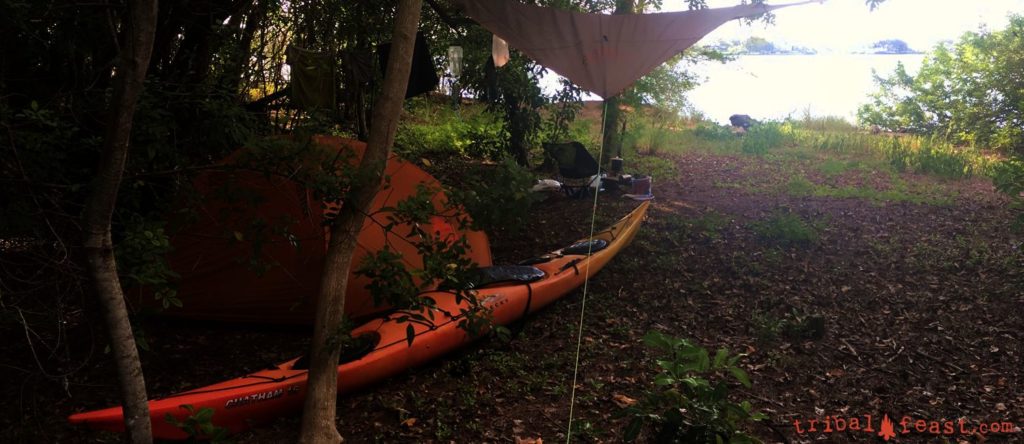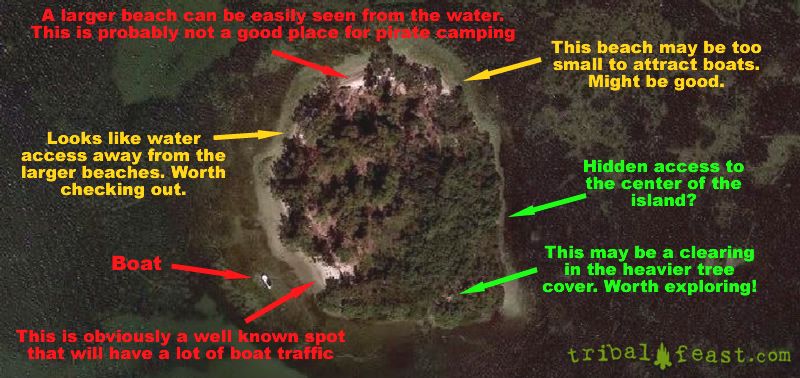If you live anywhere near the coast or a large body of water, there is a good chance there is a “Picnic Island” near you. This would be a place where people hangout for the day to picnic, swim, and basically enjoy the water.
Usually it is free to visit and often it will be little more than an ever-changing sandbar that attracts massive boat traffic and raucous party goers. However, sometimes “Picnic Island” can turn out to be something much more special.
“Picnic Island” can often refer to a natural or spoil island where outdoor recreation is legal, yet it has been somehow overlooked by the weekend warrior crowd.
These locations can offer an incredible little slice of natural beauty in an otherwise overdeveloped and heavily-trafficked coastal area. The bonus is that they are often not only great for adventure picnicking, but also offer a fantastic paddle camping destination.
An Island by Any Other Name
To be clear, the island we are talking about here may not officially be called “Picnic Island.” Other possible names for the island we’re looking for are “Beer Can Island,” “Party Island,” “Skier’s Island,” “Gilligan’s Island” or “Hidden Island.”
It could even be named after some local character or infamous local event. You may not be able to find it by name on any map, but if you ask a friendly local-in-the-know where “Picnic Island” is, you could hit pay dirt and get directions on how to get there.
Affordable Adventure for Locals
The bitter truth about living in many coastal areas is that the wants and needs of tourists and seasonal visitors are often put above those of the working class locals.
State parks commonly are geared more to RVs than tent campers, and even primitive camping nowadays can cost in excess of $35 a night. That’s a big chunk of change for a local who just wants to go for a low budget weekend campout, especially considering he or she will be stuck next to the very tourists he or she was trying to get away from.
Fortunately, in almost every bay in every coastal town there are spoil islands, sandbars, and natural barrier islands that may be an amazing hidden oasis for day and overnight trips. Some are only big enough to park a few kayaks in the sand and break out a picnic lunch. Others have extensive tree cover and may have even served as a fish camp or poacher haven in the not-too-distant past.
Don’t be surprised to find small clearings with fire rings on any coastal island with solid ground. The trick here is not only finding these island gems, but also figuring out if you can legally set foot on them.
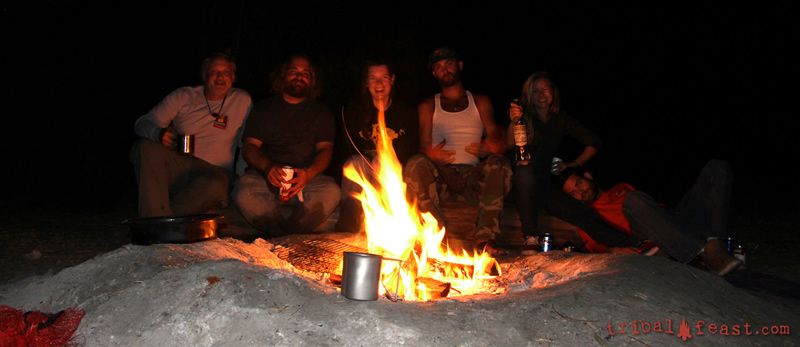
Finding Paradise Where You Least Expect it
After having lived on the Gulf Coast of Florida for nearly two decades, I came to know quite a few “Picnic Islands.” Some of are heavily-guarded local secrets, others have become tourist destinations.
So, rather than give you exact locations, I will give you some great tips on how to find these amazing and overlooked natural treasures on your own, but keep in mind we are looking for ways to identify islands, not navigate to them, so I’m not including GPS navigation services and apps.
Google Maps
Google Maps is without a doubt the best way to search an area for hidden camping and picnicking spots. Start out on a desktop computer with as large a monitor you can access. Once you’ve found a likely locations, you can drop a pin and make some notes.
Save the map and continue adding new pins from other cool hidden places you discover. You’ve just made your very own pirate map! You can even share with friends, but be careful about making Google Maps public. You might just give away your secret picnicking spot.
An added benefit to Google Maps is that once you are out on the water you can access your map with a smartphone and even update your notes on the spot. If you are headed to an area with tenuous cell service, download the map to your phone for offline use before you leave.
Nautical Charts
Nautical Charts are still very useful when searching for new picnicking and camping areas. Often there are names and navigation notes on these charts that will help you identify the island and determine if it is worth exploring or risking a trip out to try to camp there.
They do cost money (around $15 to $35), but they are typically water resistant and can be a great backup if electronics fail.
NOAA charts are great, but after having used charts for years before smartphones were a thing, I have to say I find Waterproof Charts much more useful. They will often even say whether an island is suitable for recreation and give other information helpful to an outdoors person.
What to Look For
Satellite imagery is absolutely fantastic for exploring an area without ever leaving the house. Once you get good at reconciling satellite imagery from what you experience by visiting places on the ground (or on the water), you will develop a keen instinct for identifying tucked away hidden camping spots.
Look for access points to an island first. these will either be obvious beaches, or small spots of white which will indicate either a patch of dry sand, or the wash of a small creek. either way, this means possible easy access to a good location for camping and picnicking.
If you are camping, you will definitely want to look at the heavier tree cover. If you see even the tiniest patch of color change, it could be the sign of a clearing or hidden campsite. If there is a hidden campsite, there will be water access and a trail. the question is how hidden the campsite is from the rest of the world.
In the map below, I’ve pointed out how I would read this island. This is a well known party island on the Gulf Coast of Florida, and despite the throngs of party campers that descend upon the island on any given holiday weekend, there are still some campsites tucked away enough to give you a sense of being in untainted nature.
The green arrows show tell tale signs of good camping that I am looking for, the yellow arrows being my second choice. The red locations I generally wouldn’t bother with unless I was sure no one was going to be out on the water.
Is it Legal to go to Picnic Island?
So you’ve looked on a map and found a deserted island with trees that looks intriguing. How do you know if you can legally go there?
Well, the first order of business is to determine if it has a name or there is any other way to identify it for further research. It’s common for small islets like spoil islands to not have an official name, yet have an unpublished local nickname. Along with that nickname will be the local knowledge of whether anyone has ever gotten kicked off by the Marine Patrol, Coast Guard, Fish and Game, or private landowner.
If you have a name for the island, Google like a pirate and don’t forget to dig deep for local threads in sportsman and paddling forums.
Knowing what type of island you are researching is also very helpful, so let’s go over some common types relevant to adventure picnicking and paddle camping.
Spoil Islands
A spoil island is a small body of land that was created when channels were dredged for boat navigation. The dirt, mud, or sand that is dredged up is piled up above the water surface to encourage plant growth and discourage erosion. Often there are a string of spoil islands along a long length of channel.
Because spoil islands are man made and not a delicate natural area, they are quite often designated as recreational areas. Most of the adventure picnicking and pirate camping we talk about in this article will be on a spoil island.
If you see a spoil island on a local charts, it may have a small string of letters and numbers for a name. If so, you may be able to turn up something in Google, but you can also contact the government agency responsible for managing spoil islands in your area to get information about the legality of visiting the island.
It may take some calling to figure out who is in charge, but it will save you time if you start local and work your way up. Usually it is a county or state agency even if the channel was dug by the federal government.
A great resource for learning about spoil islands, especially on the east coast of Florida is the Spoil Island Project. There are even interactive maps that identify the islands in a few counties and let you know what you can and can’t do when visiting. Kudos to them for working to preserve these valuable places and protect their recreational use.
Nature Reserves, Rookeries, and Wildlife Refuges
Hopefully we don’t have to go into this too much. If it is marked as a place set aside for wildlife, stay away! Natural habitats are disappearing at an alarming rate and we are there to enjoy nature not give it even more stress. Follow the laws, and give these places and their occupants the space and respect they deserve.
Even if an island is not marked as a wildlife refuge, be respectful of the needs of wildlife. If a large population of sea birds have taken over an island as a rookery, give them a wide berth and look for another place to camp.
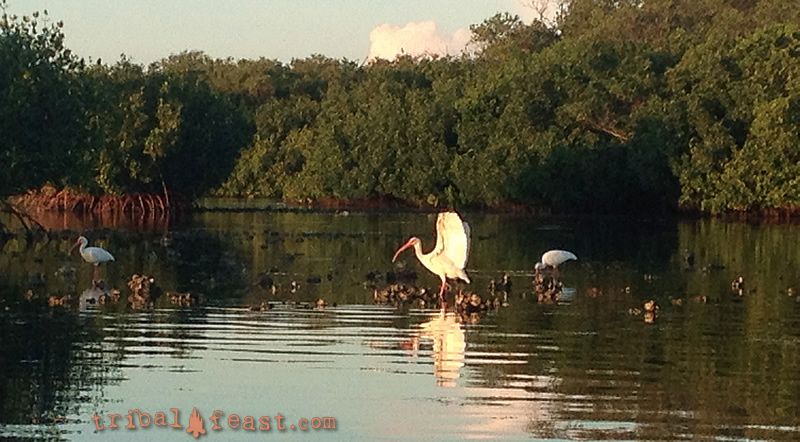
Barrier Islands
The term “barrier island” has more to do with the benefit the island provides the surrounding ecosystem and communities. It can be a large coastal island with sand dunes that block wind and storms, or a small spoil island that blocks boat wakes to keep sea wall and shoreline erosion to a minimum.
In either of these cases, harming the island’s ability to perform this function is destructive and very often illegal. Keep to marked paths, don’t walk on vegetation like sea oats that fight wind erosion, and follow any posted rules. A smaller islet may be unable to survive human traffic and may be posted as a no trespassing zone.
Private Islands
Unfortunately a lot of islands in public waterways are privately owned. More often than not they will have a sign posted clarifying the owner’s position on you.
Government Restricted Areas
It should go without saying, but STAY AWAY. If there are signs telling you there is no access, then follow what the sign says. There can be real dangers like high voltage cables and live ordinance from military testing, so take Danger signs very seriously.
Sand Bars
This last type of island is extremely common and ever changing. More often than not, sandbars are fair game for recreation, but are also very well known summer party spots due to the sandy, beach-like environment.
While that can be fun, this article is geared to more natural, adventure-oriented pursuits, so keep that in mind if you come across a tiny slice of sandy paradise on a chart or map. It may turn out to look like this:

Hopefully your research has paid off and you’ve discovered a great island to explore and possibly even camp on. Now we have to figure out how you are going to get there….
Planning Your Paddle Trip
Parking is the Biggest Challenge
Without a doubt, one of the biggest challenges of pirate camping is knowing where to park. For day trips and picnics, this isn’t such a concern, but when you are paddling out for a multiday island stay, you want to know that your car won’t get towed. This is another area where local knowledge is gold, so ask around.
Also, do your own scouting. If you see cars parked near the water and a possible launch point to get to your destination, keep tabs on how long the cars are parked there.
If you see a vehicle parked for three days over the weekend, it is a sure bet that they are island camping. And don’t be afraid to ask if you see someone loading or unloading a paddle craft and camping gear. Paddlers are usually pretty forthcoming with intel when talking to another paddler.
Lastly, as mentioned above, island camping is often the only affordable alternative for a lot of coastal inhabitants. Local law enforcement often understands this since they are full-time local residents as well.
There can be certain areas that are not only okay for you to park for free for days at a time, but will also be monitored by police since they want to keep these areas safe and low key for the local public. The bottom line: don’t be afraid to flat out ask a police officer where you can safely park for a multi-day paddle trip. He or she may even recommend a cool place to paddle camp.
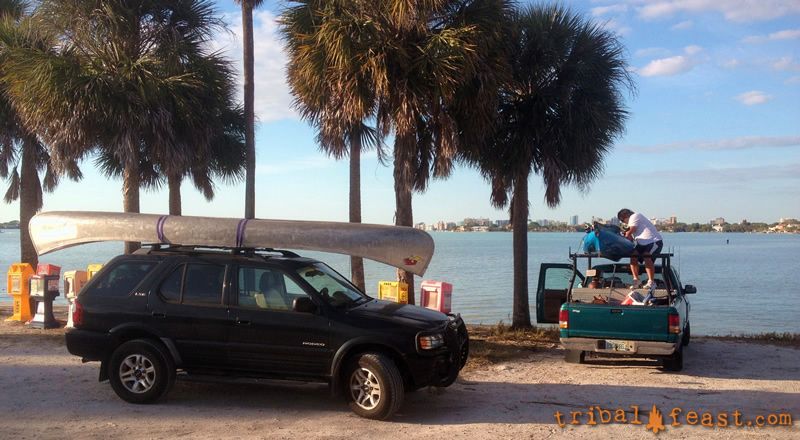
Bring Your Own Firewood
If having a campfire is legal and safe at your destination island, bring in your own firewood. Even if it is likely that there will be some firewood on the island, it is still an island and vegetation is a finite resource there. If several people are coming out, ask everyone to bring a bundle of wood, thereby sharing the load.
When out scouting, you can quickly assess how much an island is used for camping by how much available firewood is on the ground. Lots of firewood means that you better double check that you are allowed to be there. A completely bare forest floor with signs of fresh cut green limbs means you are on the local party island and are good to camp. Just bring in your own wood so you don’t add to the destruction.
Take Out the Trash
Of course you want to take out all of your own trash, but here is the thing: if you want to continue having access to the island and want to enjoy it even more the next time you come, why not take out some extra trash that you find?
Always carry numerous large trash bags when picnicking or camping on an island. A few minutes or your time devoted to making the island a better place can go along way. Create good pirate karma.
Poop Like a Pirate
If the island is large, wooded, and doesn’t seem to suffering from too much human occupation, then dropping a deuce island style should be perfectly fine. But remember, you’re a pirate. Always bury your “treasure.” You are soiling a delicate natural ecosystem so make sure there is absolutely no visible (or smellable) trace of your being there. You are the only steward for your poop so be a great one. To get you started, check out our fun DIY tutorial on how to make your very own ultralight catholer.
If it is smaller island or one that is obviously suffering from human occupation, then do the right thing. Or should we say “doo doo” the right thing. Bring along a few heavy duty trash bags, and when you are on the island, roll down the sides of one to form a ring (picture a giant condom) and place it in a secluded area. This is your portable honey hole.
When it is time to leave the island, however, you will need a brave volunteer to unroll the sides back into a bag and tie that sucker off. I’m sure you guessed what the second bag was for. Yes, double bag that sh*t because you are taking it with you! A pirate’s life isn’t always easy you know.
Every Pirate Needs a Ship
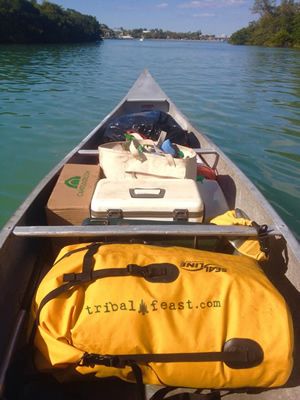
Trust me on this: ditch the powerboat and grab a paddle. Paddling a canoe or kayak with all the food and gear you need for a picnic or camping trip is a sublime experience. It’s like backpacking, but you are on the water, and you can carry more comfort gear and fresh foods.
But there is an even bigger reason you don’t want to take a powerboat to a secluded island. If you park a boat off an island, you WILL have another boat park next to you, destroying any seclusion, quiet, and tranquility you hoped to enjoy.
The reason for this is simple: most people in boats don’t know what they are doing or where they can go with the boat. They need a place to let the kids run around to scream their heads off (which they will drown out with their blaring stereo system) and you just showed them a place where a boat can safely park. Hope you like company!
If you are going camping with a group, this is even more critical. There will always be someone who wants to join just to show of his or her new powerboat. That boat will be parked out visibly all night drawing attention your way. Out on the water, a nice boat and a bonfire means a party so don’t be surprised if you have a boatload of uninvited party guests looking to liven up your quiet campfire. And now that there are two boats parked by the island, it is even more of an invitation for another.
This has happened to me every single time we camped with a boat. Every. Single. Time.
With canoes and kayaks, you can pull them up into your camp where they are not visible. Even if your campfire is spotted, it is really unlikely that anyone riding around in a boat in the middle of the middle of the night will want to check out a strange island campfire when there is no boat, since they won’t have any clues to who might be sitting around the fire.
Safety Meeting!
Before we discuss some paddle options for your pirate picnic or camping trip, we need to be certain you have all the proper safety gear like a PFD, a whistle, a spare paddle, and a crash bag with a first aid kit. We are also going to assume that both you and your craft are up to the trip. Lastly, it is important to make sure you have the proper clothing for spending the night out on the water – even if you are only going for the day.
A good pirate is always prepared for the possibility of a shipwreck. In future blogs we’ll get more in depth about paddling, but for now, please don’t go out on any body of water without the proper skills and equipment.
Canoes
After having countless watercraft, I have to say that one of my favorite boats that I’ve ever owned is a battered Alumacraft Aluminum Guide canoe I bought for $175. The advantages of a canoe as opposed to a kayak are many for island camping since you can carry more gear and people. Often we would have people in our group without watercraft. With a large canoe, it was just a matter of paddling out to pick them up like a water taxi.
There are a few other advantages of having an old beat up aluminum canoe. First of all, you can toss chords of firewood into it without damaging it. Then, once you’ve settled into our picnic or camping spot, you can pull your canoe right up into your campsite and flip it for a giant cooking table. Just use a log or rock to level it.
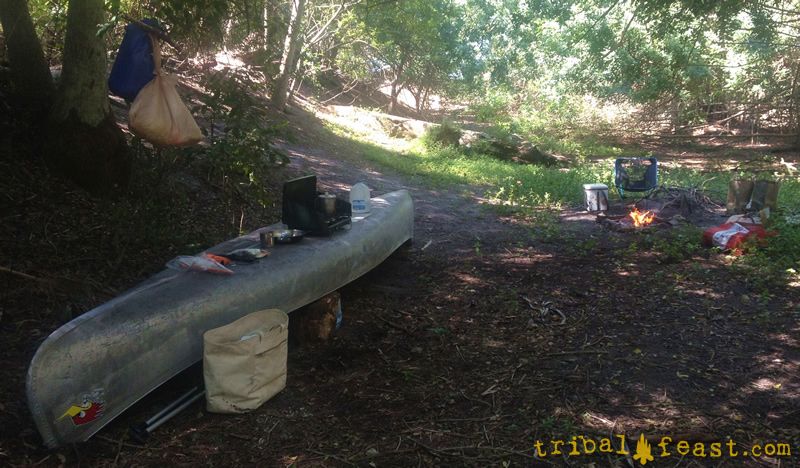
But not all is peachy for canoers in rougher seas. When a canoe tips over it is a very dangerous scenario and if it is a heavy canoe, with inadequate flotation, you may not be able to right it and get the water out without some serious assistance from a boat. Again, make sure your craft and your abilities are up to the challenges of your journey.
Sit-On-Top Kayaks
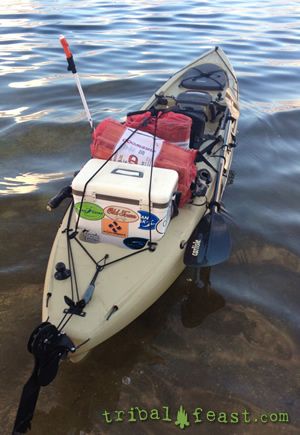
Sit-On-Top kayaks (or SOTs) are an awesome choice for island picnics and camping. They offer plenty of storage and stability. Some of the fishing models are even stable enough to be loaded down with a bit of firewood if you are camping.
A particular advantage most SOTs offer is that they are scuppered, meaning any water that enters the cockpit can leave through drains in the hull. this means they are hard to sink and are easier to recover should you become capsized – although they have such a low center of gravity capsizes are rare. Usually you just fall out and then climb back on.
SOTs can also be a great platform to fish or photograph from since they are quick, quiet, and stable. Many models these days offer pedal drives and electric motors, but avoid these. For camping these boats not only lack the needed storage for carrying larger amounts of gear, but also weigh a ton. A paddle-only SOT in the 14’ to 16’ length is a much better (and less expensive) choice.
Recreational Sit-Inside Kayaks
This type of kayak is more common in colder climates since they offer the paddler a bit more protection. Longer sit-insides in the 12 to 14 foot range can be pretty quick on the water and have adequate enough storage for camping. Like a canoe, however, they have a major weak point: if they capsize they can fill with water leaving an inexperienced paddler in a very dangerous situation.
If you plan on using a sit-inside for any bigger water paddle adventures, it would be wise to take an ACA certified safety and rescue course. Not only will you know what to do if you get in trouble, but you will also be a more confident paddler and water person.
Sea Kayak
The sea kayak is the Ferrari of kayaks. These sleek watercraft are designed to move quickly under load and in rougher conditions. They also require quite a bit of knowledge and skill to keep a paddler from getting him or herself in over their heads.
Taking an aforementioned class geared specifically for sea kayaks is a necessity. In warmer climates, paddlers often choose to paddle without the skirt (a waterproof cockpit cover actually worn by the paddler), but if your boat is loaded down, this is never a good idea. If you decide to try sea kayaking, take it very seriously. It is an incredibly rewarding sport, but also one that can take you out of your comfort zone very quickly.
As far as carrying camping gear, sea kayaks are surprisingly capable. The trick is in learning how to pack them and balance the weight for and aft. If you want to get a sense of what sea kayaks are capable of, I highly recommend the film Kayaking the Aleutians by Justine Curgenven. This entertaining expedition documentary is as inspiring as it is hair raising.
Keep It Dry
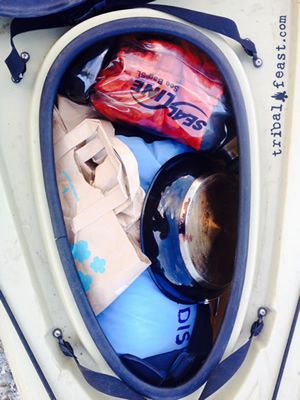
Regardless of what paddle craft you choose, invest in a good quality dry bags or two. Smaller items can be kept dry in Ziploc freezer bags, but remember that plastic bags can wear through if they encounter any friction. If you want to invest in a good personal dry bag, Sea To Summit dry bags are great quality for the price.
If you are do a lot of canoe camping, a SealLine Black Canyon Boundary Pack will become a favorite piece of gear. These large, heavy duty bags come in 35 liter, 70 liter and 115 liter sizes. They also have pretty comfortable backpack straps to make portages easier. One of my all time favorite pieces of outdoor gear for sure!
In Conclusion
Paddling out to an island for a picnic or overnight adventure is one of the most satisfying outdoor experiences one can have. Beyond the normal food and gear logistics involved with with land bound picnicking and camping, there are the added elements of navigation, seamanship, and water safety that can add positively to the experience.
There is also the added excitement that comes with doing something that is not so obviously legal at first glance. Just remember to leave the island better than you found it, respect the sanctity of wildlife, and whenever possible, speak out for the creation of more natural public spaces that give everyone a place to go when they want to get away from it all.
TRIBAL SECRET: If you are in or near Sarasota, Florida and are desperate to get away from the tourists, traffic, and overpriced shopping, go to The Shamrock Pub, put “Africa” by Toto on the jukebox, then sit down at the big table on the back patio. This song is like a secret handshake for the locals who hang out here. If anyone smiles or comments on your song choice, they may be able to help you get to one of the most amazing secret island camping destinations in the state of Florida. Other clues have been peppered throughout this post.

